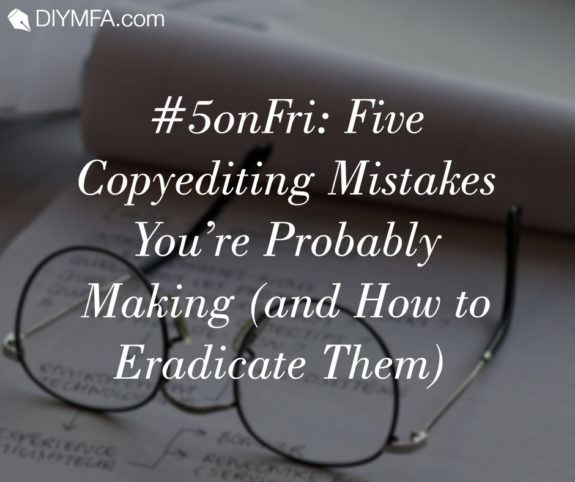As writers, I think we can all agree that copyediting is an important part of the publishing process. We know that if a reader notices an error, it will probably take him out of the lucid dream of reading. Do that enough times, and he’ll sigh with disgust and toss the book/article/essay aside for good. The problem is, many writers don’t know the rules of copyediting, let alone grammar.
The goal of copyediting is to escort the blunders out the door so your words can shine through. Whether you hire a professional for your work or not (learn more about the editorial process here), I recommend getting the manuscript into the best shape that you can. If it’s a book manuscript, your beta readers will thank you, and if it’s a news article that will appear in a local newspaper or online blog or zine, you may be responsible for the copyediting anyway.
I’ve been a freelance editor for decades, and I teach three copyediting courses for Writer’s Digest University, so I know well the mistakes writers most often make. Here are five common copyediting issues to look for and eradicate on your own.
1. Commas and Independent Clauses
Use a comma to join two independent clauses (those that can stand on their own as a full sentence) that connect with a conjunction.
Example: The bird flew up to the feeder, and the cat let out a cry.
“The bird flew up to the feeder” is one independent clause. “The cat let out a cry” is another independent clause. The two are connected with the conjunction “and.” The conjunction is paired with a comma.
Seems straightforward enough, but it’s very easy to forget this comma.
Do not, on the other hand, use a comma to separate a compound predicate. This occurs when one subject is shared by two clauses. Do not use a comma to cut the subject from the second verb.
Incorrect: Lainey went to the store, and bought a bag of oranges.
Correct: Lainey went to the store and bought a bag of oranges.
2. The Semicolon
Many writers fear the semicolon, but it has its uses. For one, you might want to connect two sentences that are very closely related, but you don’t want to use a conjunction to do so. One statement flows into the next, enhancing or expounding on it.
Correct: I am traveling to China; I’ve always wanted to go there.
Correct: Ginger swam to the other side of the lake; it really was the only option.
You will also use semicolons when dividing items in a complex list in which one of the items is a sub-list.
Correct: Her favorite color combinations were black and white; pink and green; and red, white, and blue.
3. Quotation Punctuation and Dialogue Tags
Many are baffled by the quotes, commas, and dialogue tags that are used to indicate spoken words. The dialogue tag may start the sentence, fall in the middle, or end the sentence. A sentence leading into the spoken words can act like a dialogue tag, but it will not be punctuated like one.
Example 1: He said, “You’re going to regret this.”
In this example, you have the dialogue tag at the start, a comma following the tag, and the quotation marks before and at the end of the spoken words.
Example 2: “You’re going to regret this,” he said. “Don’t say I didn’t warn you.”
Here we start with the quotation mark and spoken words followed by a dialogue tag. Note the comma at the end of the spoken words and the period following the tag, putting an end to the sentence. The speaker continues, however, with another sentence, so you start this second sentence with a new quotation mark and a capitalized word. It ends with a period inside the closing quote because there is no tag to follow. The tag in the middle works for both sentences.
Example 3: “You’re going to regret this,” he said, “and don’t say I didn’t warn you.”
Here the sentence continues after the dialogue tag, so a comma is used after the tag and a new quotation mark starts the rest of the sentence, but a lowercase letter is used to start the second phrase because it is a continuation of the same sentence.
Example 4: “Don’t say I didn’t warn you,” he said.
When the dialogue tag follows, you’ll use a comma at the end of the spoken sentence followed by the closing quote and the dialogue tag.
Example 5: James grabbed a handful of the candies by the cash register and unwrapped one. “I’m known for having a sweet tooth.”
Here the sentence that comes before the quotation indicates who is speaking. It is not treated as a dialogue tag. It’s a sentence in its own right.
4. Colon Use
I would venture to say that a majority of writers do not know how to properly use colons. Improper use appears in print constantly, so it’s certainly not their fault. Here is the No. 1 rule to remember when using a colon: a full sentence must come before the colon. (I have used the colon correctly in the sentence before this one.)
Incorrect: The paper listed ways to earn a living including: starting a business, working for someone else, getting a temporary job. (Remove the colon and add a comma after “living.”)
Incorrect: The instructions are: cut the paper, glue the paper, and color the paper. (Remove the colon and the sentence works.)
Acceptable: Pros: attractive and affordable. Cons: far from work, no animals allowed. (A single word used to introduce a list.)
Correct: The question was obvious: How would we get out of here? (Use a colon to introduce a question or quote.)
5. Dashes
Dashes work in pairs, but don’t send a dash to do the work of a comma. Save the dashes for the “special” instances when you want to set off an emphasizing statement or one that further explains. I like to think of it as going off on a quick tangent. Please note: be sure that the words before the first dash and after the second form a complete sentence.
Tangent: She worked long hours at her desk—in spite of sitting being the new smoking—each and every day.
Emphasis: He would not listen—no matter how hard she tried to explain—to any advice she gave.
Non-Essential Clause: He put the Beatles album on, a favorite of his, and sat back in the easy chair. (“A favorite of his” is the nonessential clause, and you will not use a pair of dashes here.)
Search for these scenarios in your own work, and get in the habit of using this punctuation correctly. If you can handle the above punctuation well, your manuscript will be that much closer to reaching the goal of a smooth and enjoyable read.

Kim Catanzarite has been a freelance writer and editor for almost three decades, and she teaches copyediting for Writer’s Digest University. Her debut sci-fi thriller, They Will Be Coming for Us, published June 1, 2021. You can subscribe to her self-publishing blog at AuthorKimCatanzarite.com/blog, or follow her on Twitter, Instagram, or Facebook.







